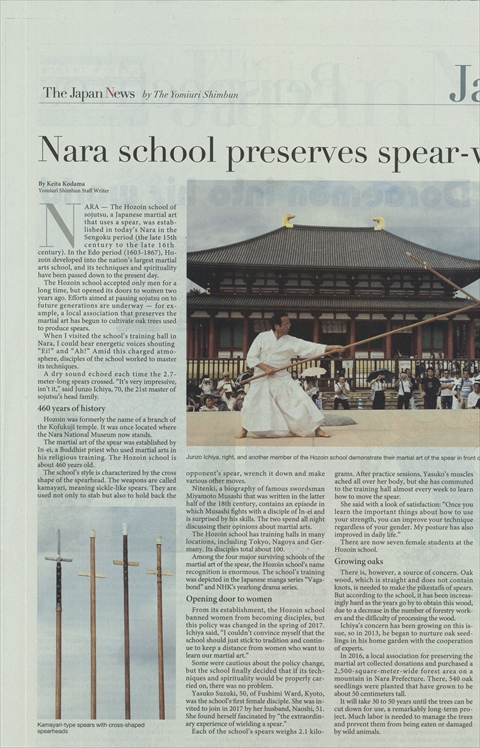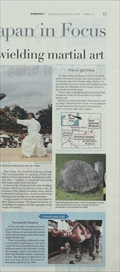By Keita Kodama / Yomiuri Shimbun Staff Writer
NARA - The Hozoin school of sojutsu, a Japanese martial art that uses a
spear, was established in today’s Nara in the Sengoku period (the late
15th century to the late 16th century). In the Edo period (1603-1867),
Hozoin developed into the nation’s largest martial arts school, and its
techniques and spirituality have been passed down to the present day.
The Hozoin school accepted only men for a long time, but opened its doors to women two years ago. Efforts aimed at passing sojutsu on to future generations are underway ? for example, a local association that preserves the martial art has begun to cultivate oak trees used to produce spears.
When I visited the school’s training hall in Nara, I could hear energetic voices shouting “Ei!” and “Ah!” Amid this charged atmosphere, disciples of the school worked to master its techniques.
A dry sound echoed each time the 2.7-meter-long spears crossed. “It’s very impressive, isn’t it,” said Junzo Ichiya, 70, the 21st master of sojutsu’s head family.
460 yearas of history
Hozoin was formerly the name of a branch of the Kofukuji temple. It was once located where the Nara National Museum now stands.
The martial art of the spear was established by In-ei, a Buddhist priest who used martial arts in his religious training. The Hozoin school is about 460 years old.
The school’s style is characterized by the cross shape of the spearhead. The weapons are called kamayari, meaning sickle-like spears. They are used not only to stab but also to hold back the opponent’s spear, wrench it down and make various other moves.
Nitenki, a biography of famous swordsman Miyamoto Musashi that was written in the latter half of the 18th century, contains an episode in which Musashi fights with a disciple of In-ei and is surprised by his skills. The two spend all night discussing their opinions about martial arts.
The Hozoin school has training halls in many locations, including Tokyo, Nagoya and Germany. Its disciples total about 100.
Among the four major surviving schools of the martial art of the spear, the Hozoin school’s name recognition is enormous. The school’s training was depicted in the Japanese manga series “Vagabond” and NHK’s yearlong drama series.
Opening door to women
From its establishment, the Hozoin school banned women from becoming disciples, but this policy was changed in the spring of 2017. Ichiya said, “I couldn’t convince myself that the school should just stick to tradition and continue to keep a distance from women who want to learn our martial art.”
Some were cautious about the policy change, but the school finally decided that if its techniques and spirituality would be properly carried on, there was no problem.
Yasuko Suzuki, 50, of Fushimi Ward, Kyoto, was the school’s first female disciple. She was invited to join in 2017 by her husband, Naoshi, 51. She found herself fascinated by “the extraordinary experience of wielding a spear.”
Each of the school’s spears weighs 2.1 kilograms. After practice sessions, Yasuko’s muscles ached all over her body, but she has commuted to the training hall almost every week to learn how to move the spear.
She said with a look of satisfaction: “Once you learn the important things about how to use your strength, you can improve your technique regardless of your gender. My posture has also improved in daily life.”
There are now seven female students at the Hozoin school.
Growing oaks
There is, however, a source of concern. Oak wood, which is straight and does not contain knots, is needed to make the pikestaffs of spears. But according to the school, it has been increasingly hard as the years go by to obtain this wood, due to a decrease in the number of forestry workers and the difficulty of processing the wood.
Ichiya’s concern has been growing on this issue, so in 2013, he began to nurture oak seedlings in his home garden with the cooperation of experts.
In 2016, a local association for preserving the martial art collected donations and purchased a 2,500-square-meter-wide forest area on a mountain in Nara Prefecture. There, 540 oak seedlings were planted that have grown to be about 50 centimeters tall.
It will take 30 to 50 years until the trees can be cut down for use, a remarkably long-term project. Much labor is needed to manage the trees and prevent them from being eaten or damaged by wild animals.
But Ichiya was forward-looking, saying: “We’re responsible for passing on this tradition to future generations. Nothing feels difficult when I imagine young people practicing with spears made from these trees.”
In front of the Chukondo hall of the Kofukuji temple, which was reconstructed last year, 10 members of the school, including Ichiya, clad in traditional training wear, demonstrated their training in the martial art in late September.
A large number of tourists were fascinated by their demonstration. The beautiful moves of controlling the spears were like a glimpse of the weight of tradition.
|







